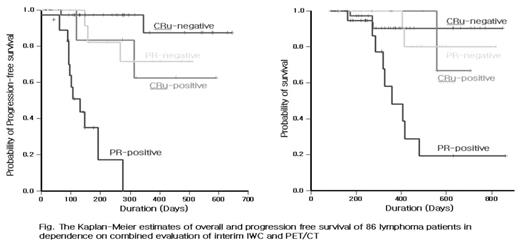Abstract
FDG-PET, a functional imaging modality used for staging and monitoring response to treatment of malignant lymphoma, has a higher sensitivity and specificity than conventional imaging. PET/CT may be more accurate than conventional imaging in assessing treatment effects to correctly identify patients with residual disease and predict therapy outcomes. We prospectively investigated that PET/CT may provide additional prognostic information in mid-response assessment prior to completion of chemotherapy.
Patients and Method: Eighty-six newly diagnosed patients with malignant lymphoma were enrolled from Aug. 2004 to July 2006. Both CT and PET/CT analysis were performed at the time of diagnosis and after the 3rd or 4th chemotherapy. The clinical stage of the patients was assessed according to International Workshop Criteria (IWC). PET/CT imaging was analyzed according to the combination of morphology using the CT portion and by the uptake and location of the FDG-PET portion. The cut off value of the positive in PET/CT was more than max SUV 3.0. We divided them into four different response groups using IWC and PET/CT (CRu-negative, Cru-positive, PR-negative, PR-positive). The limited-stage patients were treated with chemotherapy and involved field radiation therapy and the advanced-stage patients were treated with eight cycles of chemotherapy. However, advanced-stage patients who were older than sixty, if they had CRu-negative in interim analysis, were treated with only six cycles.
Results: Median age was 53.5 years (range: 19 – 85). Seventy five patients had Non-Hodgkin’s lymphoma [Indolent-11 (12.8%), Aggressive-64 (74.4%)] and eleven patients (12.8%) had Hodgkin’s lymphoma. Forty-two patients (48.8%) achieved CRu-negative, 6 patients (7.0%) achieved CRu-positive, 20 patients (23.3%) achieved PR-negative and 18 patients (20.9%) showed PR-positive by interim IWC and PET/CT. The relapse rate is significantly different between PET-positive (58.3%) and PET-negative (8.1%) (P=0.000), especially when 12 of 18 patients in PR-positive group (66.7%) relapsed after or during chemotherapy. Figures showed the Kaplan-Meier estimates of overall and progression free survival of 86 patients depending on the combined evaluation of interim IWC and PET/CT.
Conclusion: Interim PET/CT analysis was a significantly predictive value of disease progression and survival. The patients with PR-positive according to interim IWC and PET/CT analysis should be considered for an intensive therapeutic plan.
Disclosure: No relevant conflicts of interest to declare.
Author notes
Corresponding author


This feature is available to Subscribers Only
Sign In or Create an Account Close Modal